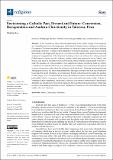Files in this item
Envisioning a Catholic past, present and future : conversion, recuperation and Andean Christianity in Talavera, Peru
Item metadata
| dc.contributor.author | Lee, Christine Shen-Chirng | |
| dc.date.accessioned | 2021-08-30T10:30:15Z | |
| dc.date.available | 2021-08-30T10:30:15Z | |
| dc.date.issued | 2021-08-30 | |
| dc.identifier | 275627415 | |
| dc.identifier | f171a648-d4b8-451d-ba62-97292ac327ac | |
| dc.identifier | 85114465941 | |
| dc.identifier.citation | Lee , C S-C 2021 , ' Envisioning a Catholic past, present and future : conversion, recuperation and Andean Christianity in Talavera, Peru ' , Religions , vol. 12 , no. 9 , 696 . https://doi.org/10.3390/rel12090696 | en |
| dc.identifier.issn | 2077-1444 | |
| dc.identifier.uri | https://hdl.handle.net/10023/23864 | |
| dc.description | Funding: This research was funded by Santander and the University of St Andrews. | en |
| dc.description.abstract | In the colonial era, many Spanish missionaries in the Andes sought a total temporal and cultural break between the pagan past and desired a Christian future of indigenous Andeans. Discussions of Christian conversion in the modern-day Andes have often echoed this line of thinking, portraying conversion—whether to Protestantism or to Roman Catholicism—as an event of radical discontinuity, and mapping the rupture of conversion onto the rupture of the Spanish invasion and subsequent evangelisation of the Americas. In doing so, however, scholars have often portrayed Catholicism as a veneer over the ‘authentic’ Andes—which was assumed to not be Catholic, and indeed could never be. Recently, however, in the south-central Peruvian Andean parish of Talavera—under the guidance of a first generation of an indigenous Catholic priesthood, made up entirely of men born and raised in the local area—discourses surrounding conversion portray the past as a source of continuity rather than discontinuity with Catholicism. Drawing from historical and ethnographic sources, this article demonstrates that although conversion has been and continues to be an important point of reference in contemporary Roman Catholicism in the Andes, the question of what people convert from has shifted. Today, the Andes are spoken of as already inherently and profoundly Catholic; conversion, in the sense of the need to make the Andes ‘really’ Catholic, is considered long accomplished. As the article discusses, in a national context where Catholicism is dominant and ubiquitous to the point of hegemony, this is an inherently political stance which runs counter to longstanding harmful stereotypes of indigenous Andeans as not ‘real’ Catholics and thus unable to be ‘real’ Peruvians. | |
| dc.format.extent | 12 | |
| dc.format.extent | 249865 | |
| dc.language.iso | eng | |
| dc.relation.ispartof | Religions | en |
| dc.subject | Andes | en |
| dc.subject | Catholicism | en |
| dc.subject | Conversion | en |
| dc.subject | BX Christian Denominations | en |
| dc.subject | F1201 Latin America (General) | en |
| dc.subject | T-NDAS | en |
| dc.subject | NIS | en |
| dc.subject.lcc | BX | en |
| dc.subject.lcc | F1201 | en |
| dc.title | Envisioning a Catholic past, present and future : conversion, recuperation and Andean Christianity in Talavera, Peru | en |
| dc.type | Journal article | en |
| dc.contributor.institution | University of St Andrews. Social Anthropology | en |
| dc.identifier.doi | https://doi.org/10.3390/rel12090696 | |
| dc.description.status | Peer reviewed | en |
| dc.identifier.url | https://www.mdpi.com/2077-1444/12/9/696 | en |
This item appears in the following Collection(s)
Items in the St Andrews Research Repository are protected by copyright, with all rights reserved, unless otherwise indicated.

